
As promised, PBOT turned on the new bike signals at the Broadway/Williams intersection today. It’s only been on for a few hours, and City staffers are now realizing that it needs some major tweaks before it’s ready for prime time.
Watch our video below for an idea of how it works…
Here’s what has changed at the intersection. There are two new bike signals on Broadway. One of them is on the sidewalk just before you get to Williams and the other is on the far (northwest) corner of the intersection. In addition, the five foot wide bike lane is now curbside the entire length of the block because both motor vehicle turn lanes are now right-turn only.
The two right-turn lanes have an advanced stop bar so that people in cars can more easily see if someone is waiting in the bike lane.
To trigger the bike signal, you must push a button that’s on the signal pole on the sidewalk. The bike signal will not activate unless the button is pushed. Bike loop detectors are in the plans, but PBOT project manager Jamie Jeffrey says the contractor is tied up on another job so they won’t be installed for a few more weeks.
How is this all working so far? Let’s just say there are some issues to be worked out…
At this time there are no “Bike Signal” signs on either signal head (they are coming though). This, combined with the fact that the bike signal is new, means that people on bikes simply aren’t noticing the new light. When I went to the site today, project crews and city staff were there stopping each person to tell them to push the bike signal button. Since the signals are turned on and they can’t stay there all night, there was some talk of just closing the bike lane temporarily until they could add signage and make a few other tweaks. (See more detailed update below)
Another issue worth noting is the turning movement of semi-trucks and large buses. If long vehicles turn right (north on Williams) from the right-most turn lane, their trailers tend to encroach on the bike lane. The city might consider moving the bike stop bar back several feet to avoid someone getting rolled over.
The intersection also lacks the flashing “No Right Turn on Red” sign that exists on the bike signal above the Eastbank Esplanade near the Steel Bridge. PBOT project manager Jamie Jeffrey said they plan to install one soon.
Also, in case you were wondering, the advance stop bar for the right-turn lanes is not a bike box, so it will not get the green thermoplastic treatment. The bike lane is also not slated to get the green treatment because if everyone follows the lights, there should never be traffic crossing over it when a person on a bike is present.
Once the city makes a few tweaks, this should be a solid safety improvement. We’ll keep you posted as things develop. More photos in the slideshow below…
UPDATE, 5:45pm: City Traffic Engineer Rob Burchfield said there are a number of things they plan to do to improve people’s awareness of the bike signal. The plan now is to put up warning signs, burma-shave style, that say, “Bike Signal Ahead,” “Bikes Use Signal,” and then another sign pointing out the push button that will go on the traffic pole.
The changes are slated for completion by tomorrow. For the rest of the peak hours tonight, a flagger will remain present. Later tonight, the right-most right turn lane and the bike lane will be closed and all traffic will transition into one of turn lanes. Then in the morning, the flagger will stay in place until the other changes are in place. “We’re definitely in a transitional period right now,” Burchfield said.



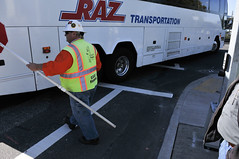
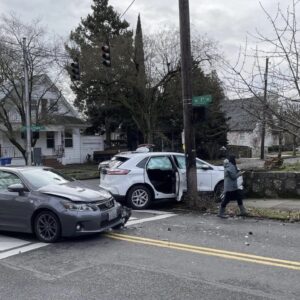
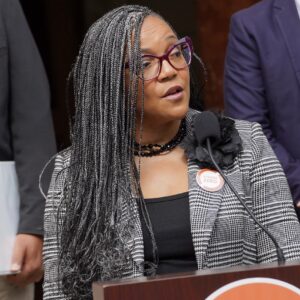
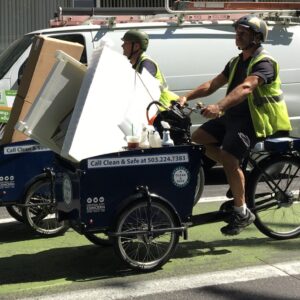
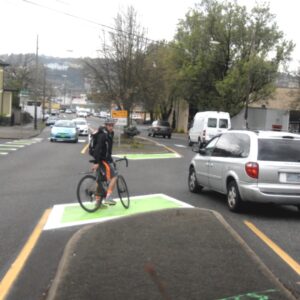
Thanks for reading.
BikePortland has served this community with independent community journalism since 2005. We rely on subscriptions from readers like you to survive. Your financial support is vital in keeping this valuable resource alive and well.
Please subscribe today to strengthen and expand our work.
Checked it out last night, on foot. Looked good. Then I saw a cyclist pull up, frustratingly hit the button a few times, then ride against the red anyway. It is a little odd to have a flowing street that is now basically a required stop.
No. Thanks.
I’ve been right-hooked too many times. I will not be using a curb-side bike lane with two right-only lanes running across it.
I’ll treat this intersection how I always have- move left into traffic two lanes and cross the intersection with the rest of the traffic moving straight through.
Don’t get me wrong- for less aggressive riders this is an encouraging facility. Stop, wait for the bike-only light, proceed ahead.
Not for me.
Sounds like it’s not quite ready for prime time. Half-assed implementation doesn’t serve anyone well.
Wish there was a way they could do this without making the option of taking the lane quasi-legal… It should be a no brainer that if people don’t want to sit and wait they can move over a couple lanes and take the straight through lane, but some of our more aggressive cops (I’m looking at you barnum and balzer circus) will probably not grasp this…
Sweet! I have a few questions:
1. Are bikes bound by the “No Right on Red”? Seems like they would be, but it’s not clear from the sign placements and the westbound-to-northbound turn movement is fairly popular for people on bikes.
2. Why didn’t they install a separate ped/bike-activator closer to the lane? It seems needlessly far from the curb.
3. Will it now be legal for pedestrians to cross Williams on the north side of Broadway? I can’t think of a good reason that pedestrians shouldn’t be able to take advantage of the new bicycle portion of the signal cycle.
so let me get this straight. there is an advanced stop line, but the cyclist has to stick to the curb in order to activate a switch. got it.
The “Bike Light” sign and “no turn on red” and “magnetic loop switch” will be installed “soon”. Why wouldn’t a project manager require all these parts to be launched together? Amazing!
This reminds me of the W. bound west side of the bridge where the light is red until activated. I guess if I take the lane at Williams, and just stay there all the way over the bridge, neither of these systems will reduce my trip time.
Whats the timing of the light? How long does it take after pushing the button to get the bike light?
Im going to guess soft hit posts will be installed shortly after the first cyclist is killed by a turning bus or truck.
Also, I second the idea that a pedestrian crosswalk should be installed to cross during the bike phase.
#5 David – having a pedestrian cross the north side of the intersection would take a lot longer than the bicycle gets the green for. There’s not a lot of destinations on the northside of the street, you’d have to be walking from the Toyota dealership to the Rose Quarter and you’d still have to cross, it’s quite a ways west and you’d be walking across the freeway off ramp traffic.
#7 suburban – The City doesn’t often specify how the contractor must stage the building of the intersection. We may change that in the future to address the concern. You can think of it as if someone is remodeling your kitchen. You wouldn’t tell them what to do step by step. Sink first, cabinets second…
#8 JJ – The cycle length is 70 seconds. The maximum delay is 60 seconds.
The contractor has not installed the loops because the intersection is still in a construction phase right now and the loops may be destroyed by the vehicles still out there.
#9 JJ – adding that pedestrian movement would add a lot of delay to the entire intersection and the pedestrians and bikes on the north-south movement. N Williams carries a lot of people on bikes.
Why didn’t PBOT install the large bright LED flashing “no right turn” lit up sign that comes on when the bicyclists have green?
Like the one they have at the bike signal on the westside of the Steel Bridge bikepath as you head up to the Rose Quarter?
This is a much more dangerous intersection than the Steel/Rose Quarter intersection -for the sake of people’s lives, it deserves a flashing NO TURN sign, stat.
I think this simply a case where the city should’ve accepted a higher level of congestion and removed one of the right turn lanes. It’s not like I-5 can easily accommodate two full lanes of traffic pumping into it in the peak periods anyway.
Nonetheless, this is definitely an improvement over what was there before and I appreciate the City’s efforts in making it safer. Most cities wouldn’t have considered making any improvements and simply ended a bike lane one block before the intersection leaving the bicyclists to scramble for safety. While that works for a handful of people, that isn’t going to pass muster with the majority of the traveling public who are less daring.
In a perfect world, the whole system would have come online at 100% completion. But real-life being what it is, that didn’t happen. I’m sympathetic because in my experience it can be difficult to make contractors stick to a set time-table. This will undoubtedly be a safe crossing, which is again great for the “curious but cautious,” crowd – but as other commentators observed does little for the faster-paced daily bike commuters.
And I’m OK with that.
From what is reported here (I have yet to ride it) there are some other opportunities (tweaks) to make this function better (safer) for cyclists:
– install a ‘blackspot mirror’ under the bike signal head (for cyclist visibility by right hooking truck operators),
– is the far side signal for cycles? – I cannot see from the video if it has a bike symbol or not (if not then will this lead to confusion?)
– install a smaller bike signal head lower on the nearside pole so cyclists can see it when stopped at the existing stop bar (can they see the current nearside green bike signal now when stopped?) – this instead of a far side bike signal head to reduce drivers confusing the bike greed signal for their green and thus a turning conflict into thru cyclists (?)
– can cyclists (say a mother with child in rear child seat) balance when stopped and reach the push button (it seems to be 8 to 12 inches too far off the kerb as compared to Dutch standards in the CROW manual)
– if no to the above item – then how about installing a little higher kerb so waiting cyclists can rest their foot on it when stopped…helping to balance against it to reach the push button,
– any plans to install additional bike stencils in the conflict zone of the junction (I know there should be no ‘conflict’ due to the separate phases…but drivers and cyclists are people and need a reminder about potential conflicts in new facilities)
– how about updating the right turn signs on the approach and at the junction mast arm to include the right turn movement across a bike lane?
This looks to be ‘safer’ than the old set up…but I still believe this intersection would be safer still with only 1 right turning lane. It is the old story of car capacity over traffic safety for vulnerable road users. This may be due more to ODoT priorities than BPoT in this case.
Todd, reporting from Amsterdam today…
I guess I coined a new term in my typing haste: ‘greed signal’…when cyclists what separate signal phases…;-0
Thumbs…DOWN. Way over-engineered.
Issue #1: Cyclist rollin’ blind spot.
Issue #2: One too many lights for motorists to digest.
Issue #3: Cyclist stopped in the blind spot.
Lose all lights and use roundabout.
My point exactly.. contractors are paid money to do what it says in the contract, not just bid and build what it shown in a drawing.
I don’t buy the contractor excuses. It’s beside the point. Close the entire lane if the the various components need to come on line slowly over several days or weeks. Don’t open a high-traffic intersection with new, potentially confusing signals when it is incomplete and unsafe. If a bridge across a river was done except for guardrails because for some reason they had to be installed later, would we open that bridge?
Paul, I’m sick of all your armchair nay-saying. At least read the article first – there’s an advance stop bar for cars so cyclists are waiting at the intersection ahead of motorists (not in a blind spot). And a roundabout make NO sense for that intersection; it’s the intersection of two one-way streets. Yeah, think about it for a second. Maybe use teh internets first and pull up a map before spouting off nonsense.
Constructive criticism is great. Your comments, lately, are anything but constructive.
I do appreciate that PBOT is reviewing its design and making adjustments in response to feedback. Design is a learning process, so thoughtful and specific comments (like many posted here) from the users of this intersection will help improve their work. Sometimes it takes some use to identify the weak spots in a design, and the engineers in their building won’t see these – you will.
Don’t waste an opportunity – forward your comments on to the project PM and help your fellow cyclists out with your good ideas.
Rode through this intersection this morning…I think it would be pretty decent if they timed the light a little differently…as a bicyclist you’re pretty much guaranteed to get stopped at Victoria and then also at Williams – pretty slow and frustrating.
The dude helping at the intersection this morning was pretty helpfull and had to tell a lady in the lane next to me multiple times to not make a right on red ….driving is soooooo hard sometimes
Took Williams/Broadway this morning heading north/south (the direction they haven’t done anything on). The whole area has a lot of life-threatening risks (blind spots, pinch points, et al). The only thing keeping bicyclists alive is the hope that all the thousands of motor vehicles will follow the law to the letter. Even just a vehicle-to-vehicle crash (a daily occurrence in any city) could spell doom for any passing cyclist.
I’m willing to give PBOT the benefit of the doubt for now, but I’d still recommend routing around that area if at all possible.
I changed my commute to hit the intersection heading north/south instead of the east/west chaos. I’ll continue to do that. (Though even from that direction, they need to fix the pinch point and do something about the bus stop.)
Always a fan of cycle tracks & elevated bridges.
@Rebecca – “Forward your comments on to the project PM and help your fellow cyclists out with your good ideas.”
That’s a good idea (though a lot of us don’t hear about the projects until groundbreaking). Do you know the who and how?
Please, please, PLEASE get a blinking “NO RIGHT TURN ON RED” sign going.
There’s been at least one intersection, with a bike box no less, that was made “no right turn on red,” and I’ve seen drivers ignore that and turn right anyway.
“In a perfect world, the whole system would have come online at 100% completion. But real-life being what it is, that didn’t happen.”
Oh. You mean in the world where only autos are involved? No signal intended to control only auto traffic would EVER be brought online like this. No signs indicating that the new signal is a bike signal? How many myopic, inattentive drivers are going to plow ahead into their right turns when the bike signal across the street turns green? No orange-flagged signs indicating “Traffic Control Change Ahead”? These are standard practice for changes like this that don’t involve bikes–where are they? Activating the signal before detector loops are installed? How many auto signals go into operation with the expectation that drivers will pull up to the curb and push a button to get their green? No “No Right Turn On Red” signs? I would bet my entire retirement savings that if this was a new MAX crossing, those signs would have gone up before the tracks were even finished. Advance stop lines that put cyclists on the turning track of big rigs? Had this been engineered for motor vehicles, that research would have been done and calculations made to keep cars out of such a hazard zone. Sounds like this will eventually make for a somewhat safer crossing, but it appears to have been phased in a bit–if not carelessly–backwardly.
“I do appreciate that PBOT is reviewing its design and making adjustments in response to feedback.”
There should be no feedback necessary. We should be able to follow the same principles that are followed when implementing any traffic control change. Why is this so hard? Why is there such a rush to get this signal going that proper rollout protocols couldn’t be followed? I think this quote from the article gives us a clue: “…because both motor vehicle turn lanes are now right-turn only.” Ahhhh. Now I get it. The rush is not to make the intersection safer, it is instead imperative that two lanes of auto traffic be able to turn right ASAP. Throughput of cars trumps safety once again.
Sorry to sound so negative, but something like this–with the problems and “still to do” items identified right in the article–should not be operational yet. Safety will suffer (if only temporarily) in the rush to facilitate motor-vehicular movement.
The no right turn on red is absolute necessity in this case. I’m shocked that they would let this go live in any way without installing that sign first.
@16 Roundabouts instead? That’s almost as ridiculous as replacing stop signs with yield signs.
-We don’t want to be like Europe.
-It’s a well-known fact that European solutions don’t work over here.
-Roundabouts would require slowing down to well below the 35-45 city arterial speed limits to avoid SUV rollovers.
-Traffic lights create jobs
-Massive signage and lights keeps road users engaged
-The stop-idle-go of traffic lights allow road users to relax before their rapid accelerations and speeding.
-Reductions in gasoline consumption would lead to increased taxation elsewhere.
No more rubbish about roundabouts please.
I passed through there late morning today, and was confused by the new pavement markings. I usually take the regular lane instead of the bike lane, and it appeared that I needed to be one more lane over to the left. There were some people on the sidewalk to the right working in orange vests and hard hats that called out and pointed out the new lane by the curb. I told them “that looks more dangerous” and they seemed really disappointed. Had no idea about the signal and hope it works out. I’m glad they’re willing to work out the bugs.
@John – You might try the PBOT Transportation Safety/Neighborhood Livability
line(503-823-SAFE or safe@portlandoregon.gov). Try referencing the PM (Jamie Jeffrey, according to this article) in your call or e-mail, and it can be directed to the correct person more easily.
Several people have mentioned that a “No Turn on Red” would improve conditions at this intersection. It would certainly ease my mind to see that installed as well. Let’s see how many calls/e-mails it take to make it happen. (I count 1.)
Rebecca and others,
I just posted a major update — read it here — with a list of changes PBOT says will be coming to this project very soon (as in today, in most cases).
Can we all just pitch-in and buy the city some bags of concrete? I’ll buy the first couple bags.
Come on, Portland.. let’s go ALL IN on this one! Plastic bollards are an example of an easy, experimental, and cheap solution to get the ball rolling.. and I think they avoid additional water management costs. Something like this, maybe? http://www.flickr.com/photos/intersection911/4333188419/in/set-72157623236803669/
I understand it’s complicated, but so is planning a new streetcar loop through the city. If we don’t step up and ask Portland to do better and deliver it, we’ll never see it better than this.
I sounded too grumpy on my initial comment, I do really appreciate anything that helps make it safer to bike in this city.
I just see the huge work projects come and go on big streets in this city, and then I don’t see amazing bikeways coming out of them. When we’re spending money, ripping up the street, throwing up signals, I think that’s the best time to leverage our BMP to do something more innovative.
ODOT & PBOT are working together on a plan for this area called the ‘N/NE Quadrant and I-5 Broadway Weidler Plans’
Check it out if you see the potential for a world-class facility here: http://www.portlandonline.com/bps/index.cfm?c=52841
I third the suggestion mentioned by a number of people above – please GET A LIT UP BLINKING NO TURN ON RED ARROW SIGN for car traffic.
@Elliott, #19, Would We Be More Considerate Road Users Without Traffic Lights?
“Much of what has gone on in highway design and operation practice has represented activity without sufficient thought.” Highway Safety, Design and Operation. Report 93-7. Subcommittee on Investigations and Review. Committee on Public Works, U.S. House of Representatives, July 1973.
“The fallacy has been to cram ‘good medicine’ down people’s throat because the ’experts’ thought it was good for them.” Fisher, E. G., and R. Reeder. Vehicle Traffic Law. Traffic Institute, Northwestern University, Evanston, IL, 1974, 20, 29.
“Advertised as a panacea for all traffic ills in its early days, the traffic signal turned out to be one of those medicines that cures one disease and gives you another. It has been known since the late 1920s that signals reduce right-angle accidents at the cost of causing more rear-end and left-turn collisions.” Manual on Uniform Traffic Control Devices. BPR & AASHO, 1935, 63.
The closest deliberate, though unintended, U.S. experiment I’ve experience in losing traffic lights was the Denver 2008 DNC. Cops seemed to be more on the lookout for the really bad stuff like anarchists, terrorists, and obvious Muslims, not red light runners. So, for cyclists with bike messenger tendencies, it was a field day.
Also, whenever the lights go down, along with power, there’s not a sudden rash of deaths and injuries from crashes at the intersections. Everybody simply get more polite.
Given the preponderance of evidence, there is NO government interest in installing and maintaining traffic lights. The government is simply inconveniencing the general travelling public. In fact, government encourages criminally insane motorists to criminally speed just to catch the next red. ~~~Confused, da cuz.
Paul, your comment in #35 doesn’t seem to respond to anything I say in #19. You’ve been trotting out those quotations a lot lately, but I fail to see how two or three sentences from forty year old publications constitutes a “preponderance of evidence”.
We don’t disagree that signalization has its drawbacks and roundabouts can offer some benefits. But I take issue with your knee-jerk response (in #16) to the treatment they’ve designed given that you have no experience with the intersection in question (you live in Tulsa, right?).
Here’s an exercise for you. Go take a look at the intersection (click here), and draw up how you would redesign of the intersection. Sketch out how traffic would flow around a roundabout there (never mind that the intersection is already elevated over I-5, and an entire new structure would have to be built in order to accommodate one). Tell us what you find.
Then, after you’ve discovered that roundabouts offer no benefits over signalization at the intersection two one-way streets, you can work through the alternatives. Maybe after you’ve done some thinking about the design, you’ll find some respect for the engineers who worked hard to find an improvement in spite of the many constraints that exist there.
I don’t think the new bike signal is perfect, but it’s better than what was there before and I respect the effort that PBOT has made to improve comfort and safety for cyclists at the intersection. As someone who actually lives and bikes in Portland, I’d appreciate it if you could find a bit more respect before criticizing the work that people are doing here to improve conditions for bicyclists.
#36 Elliot (and others) – There have been a number of changes at the signal. What would you recommend PBOT do to make the signal even better?